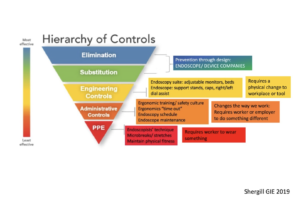
Endoscopists deserve better tools and systems to improve the ergonomics of endoscopy and reduce endoscopy-related injuries, according to Amandeep Shergill, MD, MS, professor of clinical medicine at the University of California, San Francisco and San Francisco VA Medical Center, who spoke about the issue at Digestive Disease Week® (DDW) 2022.
“Multiple survey-based studies have documented a high prevalence of injury among endoscopists, perceived to be related to endoscopy,” said Dr. Shergill. “You just have to take one look at an endoscope to realize it’s such an archaic tool. You have a one size-fits-all design when we’re not all the same. Unfortunately, there has been a lack of innovation in endoscope design for decades.”
Dr. Shergill has investigated some of the risk factors that contribute to endoscopy-related injuries. “Throughout the whole procedure, there is a huge load on the thumb, wrist and distal upper extremities that can contribute to injury,” she said. “The work is so high risk that the job needs to be changed.”
Much of the focus on decreasing endoscopy-related injuries has revolved around things the individual practitioner should do. But the most impactful measures are those that can only be implemented at a more systemic scale.
“We talk a lot about the endo-athlete,” said Dr. Shergill. “But terms like this put the burden onto the individual physician. Instead, we need to take an ergonomics approach that focuses on designing jobs and workplaces to fit the users, which consider the strengths and limitations of all users. Endoscope companies, hospitals and endoscopy suites need to implement engineering and administrative controls to reduce risk.”
Dr. Shergill described several layers of control that can reduce endoscopy-related injuries.
Redesigning endoscopes: The most impactful measure would be to re-design endoscopes to be more intuitive and tailored to the user. Unfortunately, this is also an area where endoscopists have the least control.

Creating a culture of safety. Hospital administrators also have a responsibility to create a culture of safety and prioritize ergonomics and ergonomic education. Dr. Shergill recommended measures like taking an ergonomics timeout to ensure the room is set up and optimized for safety before starting a procedure. Conscious scheduling practices, like avoiding back-to-back days of endoscopy and building in rest periods are also important.
“Unfortunately, there aren’t a huge number of things in the toolbox,” said Dr. Shergill. “We really need changes to endoscope design that are more inclusive and accommodate the diversity of users. As endoscopists, we need to come together as one voice and advocate for that.”
Dr. Shergill gave the oral presentation, “The Ergonomic toolbox: What every endo-athlete needs to know” on Monday May 23, at 10:33 a.m. PDT as part of the “Focus on GI Career: An ASGE Women In Endoscopy Symposium.”



